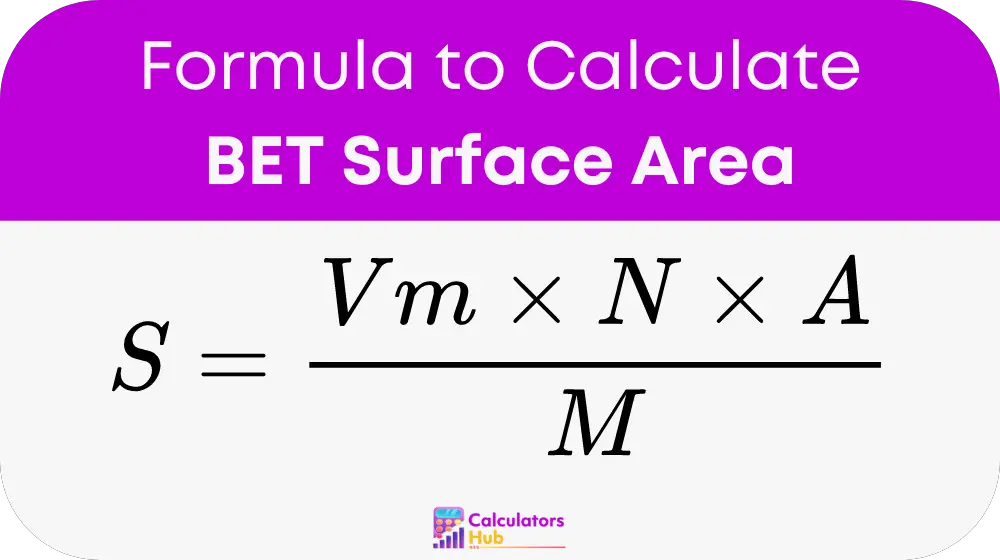The BET Surface Area Calculator is a valuable tool in the field of material science, particularly for researchers and engineers working with porous materials. This calculator estimates the specific surface area of a material by analyzing the adsorption of gas molecules onto its surface. The specific surface area is a crucial property, especially in catalysis, adsorption processes, and material characterization, as it directly influences the material's reactivity and interaction with its environment.
The calculator applies the Brunauer, Emmett, and Teller (BET) theory, which extends the Langmuir adsorption model. It helps in determining how much surface area is available in a material by calculating the amount of gas required to form a monolayer on the material's surface. By using this calculator, one can easily convert experimental data into meaningful insights about the material's surface characteristics.
BET Surface Area Calculation Formula
The BET equation is used to describe the adsorption isotherm, and the specific surface area is calculated using the following formula:

Where:
- S is the specific surface area, measured in square meters per gram (m²/g).
- Vm is the monolayer adsorbed gas quantity, measured in cubic centimeters (cc) at standard temperature and pressure (STP).
- N is Avogadro's number, which is 6.022 × 10²³ molecules per mole.
- A is the cross-sectional area of a single adsorbate molecule, measured in square meters (m²).
- M is the mass of the sample, measured in grams (g).
This equation allows researchers to calculate the specific surface area of a material based on the amount of gas adsorbed onto its surface. The result provides valuable information on the material's properties, which is critical for various applications, including catalysis and adsorption studies.
Common Terms and Conversion Table
To assist users in working with the BET Surface Area Calculator, here is a table of common terms and conversions that are frequently used in material science calculations. This table serves as a quick reference, reducing the need for repeated manual calculations.
| Term | Symbol | Value/Conversion |
|---|---|---|
| Avogadro's Number | N | 6.022 × 10²³ molecules/mol |
| Monolayer Volume | Vm | Measured in cc at STP |
| Cross-sectional Area | A | Depends on the adsorbate molecule, typically in m² |
| Mass of Sample | M | Measured in grams (g) |
| Specific Surface Area | S | Result in m²/g |
| Standard Temperature | - | 0°C or 273.15 K |
| Standard Pressure | - | 1 atm or 101.325 kPa |
This table provides a concise overview of the essential parameters and their units, helping users understand the components involved in the BET calculation and ensuring accurate results.
Example of BET Surface Area Calculator
Let's walk through a simple example to demonstrate how the BET Surface Area Calculator works.
Imagine you have a sample of activated carbon with the following parameters:
- Monolayer adsorbed gas quantity (Vm): 100 cc at STP
- Cross-sectional area of nitrogen (A): 0.162 nm² (1.62 × 10⁻¹⁸ m²)
- Mass of the sample (M): 0.5 g
Using the BET formula:
S = (Vm * N * A) / M
Substituting the values:
S = (100 * 6.022 × 10²³ * 1.62 × 10⁻¹⁸) / 0.5
S = 1.949 × 10² m²/g
So, the specific surface area of the activated carbon sample is approximately 194.9 m²/g. This result indicates that the activated carbon has a large surface area, making it highly effective for adsorption processes.
Most Common FAQs
The BET method is primarily use to determine the specific surface area of materials, particularly porous materials like catalysts, adsorbents, and powders. It helps in understanding the material's ability to adsorb gases, which is crucial for various industrial applications.
The monolayer volume (Vm) is typically determine experimentally by measuring the amount of gas adsorbed onto the material's surface at different pressures. By plotting these data points and applying the BET equation, the Vm value can be extracted.
The specific surface area is essential because it directly affects a material's chemical reactivity, adsorption capacity, and overall performance in various applications. A higher surface area usually indicates more active sites available for interactions, making the material more effective in its intended use.